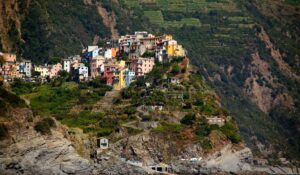To comment or receive more such wisdom, please register on www.gyanalogy.com/login

A man-made disaster?
I couldn’t explain that feeling. But all I could say that I wanted to get rid of it as soon as I could. But it seemed like there was no way out. My feet inside those wet socks were there to stay for quite some time. While trekking I have had many episodes of discomfort and pain but the worst of my horrors was getting those socks wet inside those chunky trekking boots. It isn’t supposed to rain in the first half of June but it did and it did like it was getting paid for it. The first three mornings I woke up, I changed my socks but from the fourth one I was so habituated or rather hopeless that I put them on without even looking at the sky. The early arrival of monsoon rain was unexpected and relentless; a nightmare for any trekker. But eventually the discomfort gave way to anxiety as I was getting worried about getting back to the civilization. Through my limited knowledge of geology I knew that the Uttarakhand region in the Himalayas is one of the most fragile zones with respect to landslides and flashfloods. At that time the worst that I could think of was missing my flight back home due to delays on account of landslides. Little did I know that there was a calamity waiting right around the corner which I narrowly escaped but which more that 5,000 people and many other living creatures could not.
The Uttarakhand flash flood of 2013 possibly could not have been avoided. After all it was the result of unexpected meteorological and geological reasons. But nevertheless the impact of the catastrophe could have been less severe. Human misadventures in the recent past have raised the odds of a major calamity. In this piece I would focus on two such issues.
My journey began when I took a warm shower in Rudraprayag and was thankful for the electricity from the hydropower turbines. Soon after I had my hearty breakfast and boarded the cab which looked like it had carried at least three times the load it was supposed to do on each trip. However the driver was quite skilled and without any fear we were enjoying the cool pristine air. But that was soon put to a halt. We were soon scrambling to find a piece of cloth to cover our noses. My eyelids did not want to stay open but my curiosity was too much to hold them shut. And then I saw it. It was the same dam that I was thankful to in the morning for providing me provide the warm water. While I was just vexed by the air pollution at that time but after the disaster it occurred to me how a poorly managed dam construction project may have been a cause for this and possibly many more to come.
Studies have shown that relentless dam building and altering river courses puts tremendous pressure on these sensitive ecological regions. According to a paper published in 2013 topography alteration by dams do cause the severity of the impact of flash floods to increase. As per a New York Times article some 400 dams are under construction, or planned for the coming decades, in the Indian subcontinent; at least 100 more have been proposed in Tibet. While we do need development and clean energy, numerous studies have shown that dam building, that too in fragile environments, does more harm than good. They range from ecological, natural hazards to geopolitical flashpoints. I would leave the topic of geopolitical conflict for now as I have decided to discuss only those which were rather obvious to be during my trip.
On the ecological front, we have quite a few examples where dam building affected biodiversity in the surrounding region. Aswan dam in one classic example. The change in flow of the river affects migration pattern of fish. In additional the flooding cycle of the river is disrupted which causes the soil downstream to become less fertile. Also as forests are submerged, the biodiversity of the region is affected. While the effect of all these is not immediate, in the long term their consequences can be catastrophic. Consider the example where one of the important participant of a food chain is lost like the wolves of Yellowstone. How much can they affect the thousands of acres of surrounding ecology? We all know that once they were re-introduced.
The more drastic and immediate consequence may be in the form of natural hazards. The great Himalayas were formed due to the collision of two giant tectonic plates which are still moving. This means the region is bound to see many more earthquakes. As this article in The Mint newspaper discusses the region may be awaiting a bigger compared to anything we have witnessed in the recent past. Large scale dam construction, without taking into account the impact of global warming on the flow of rivers, have been often sighted as a crisis in making. In addition due to their sheer size and capacity any minor seismic activity which may cause damage to these megastructures can have tremendous consequences.
Even if we do arrive at a point where we build dams very selectively we are still left with managing the waste during the entire project. Such large projects in remote areas require meticulous planning for waste disposal. The task of waste disposal needs a relook from the fact that travellers in the once pristine Himalayas now regularly advised to carry masks. Clearly much more needs be done than simply dump the muck along the riverbanks. The Chopra committee findings show how the improper dumping resulted in the 2013 Uttarakhand deluge to reach catastrophic proportion. Solving this issue needs a much more structural change in the attitude of how things are performed in India; a need to stop the widespread worshipping of “Jugaad” (makeshift solution). My idea in this article is not to delve deeper into that. But for those interested, this article discusses this malaise in more detail.
Secondly, the problem of over tourism also plays a big role in aggravating the calamity. Nowadays one does not need to make a check at any ticketing office counter to know how many tourists are making their way to the Himalayas. The mile long traffic congestion with overloaded buses and cabs are evidence that the Uttarakhand region has become much more accessible than in the past. But that has brought a whole new set of problems. While this was not a first order reason for the Uttarakhand floods, it did materially worsen the death toll and made the rescue operations more difficult. Additionally so many unchecked tourists in the delicate ecosystem puts a tremendous strain on the resources. Consider the many fold increase in traffic in recent years. A study by the University of Cincinnati found high level of sulphur and other carcinogens on the Manali-Leh highway. From diesel fuelled trucks and relentless construction to ancient cooking methods using solid fuels, the environment is literally dying.
Furthermore, ever increasing vehicles loaded with tourists to the bumper and the constant spawning of commercial buildings at the expense of forests is adding to the problems. During my entire trip I could witness those dangerously hanging hotels and lodges along the banks of the turbulent rivers that puts the jungle boy to shame. In fact during the flood these were the first ones that were washed away. Even without such a flash flood of the intensity of 2013 one, regular rains and slight alteration in the river’s course mean these strategically but precariously positioned structures are poised for catastrophe. And don’t all of us encounter those sad mishaps where we see buses loaded with tourist falling off from the roads?
Another aftermath of extreme tourism is the issue of waste disposal. This article published in The Times of India newapaper shows the extent of the problem at hand. I need not elaborate how much menace these cause. In my opinion the issue of waste disposal is very cultural. My trekking experience in Nepal resonates with this blog post where I think a bulk of the problem is the mindset of the people in the subcontinent. This is something which doesn’t have immediate economic benefit and needs to be tackled through widespread awareness alongside some government initiative.
One may argue that we derive around 63% of our power from thermal sources and hydroelectric provides a cleaner and renewable alternative. While I will not say in favour of thermal sources, I would argue that there are other cleaner alternatives as well. Wind, solar, tidal and biomass have considerable promise. On top of that building dams by itself is not a hazard but building them without a thorough analysis of the underlying topology and ecology is a recipe for disaster. It is encouraging to know that the stay orders have been put on many new projects. However, once we have a proper plan in place to grant projects we must also focus on finding and unwind those that pose considerable threat to the biosphere.
Proponents of tourism also point to the help it provides to existing population. But they fail to account for the loss these black swan events, which are not as rare as thought with increasing neglect, cause to the wealth and income of the locals. Finally we have to achieve a sustainable model. This would require government and public’s initiative to enforce and follow rules, put appropriate waste management practices in place. India’s leading universities should work hand in hand to design a better and safer Himalayas. These can be in the form of better structures, city planning and disaster management practices.
 Rahul Ghosh is an investment banker in Mumbai. he loves to trek, explore nature and climb mountains. He was a weight lifter at university and loves extreme sports. He has a B Tech from IIT Kharagpur and an MBA from IIM Bangalore.
Rahul Ghosh is an investment banker in Mumbai. he loves to trek, explore nature and climb mountains. He was a weight lifter at university and loves extreme sports. He has a B Tech from IIT Kharagpur and an MBA from IIM Bangalore.
The views, thoughts, and opinions expressed in the article belong solely to the author.
To comment or receive more such wisdom, please register on www.gyanalogy.com/login

